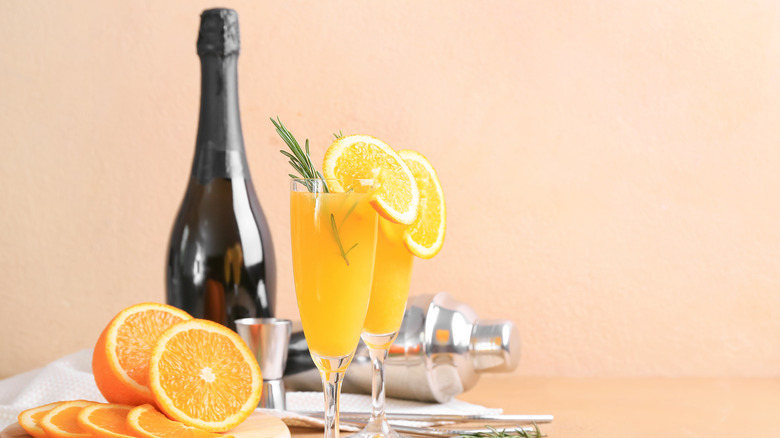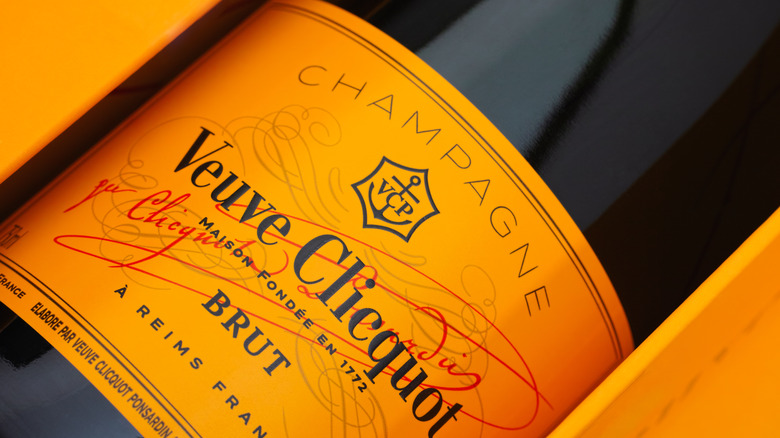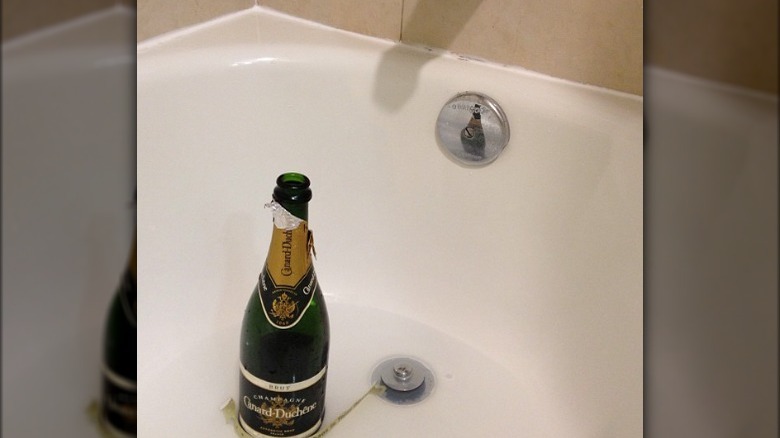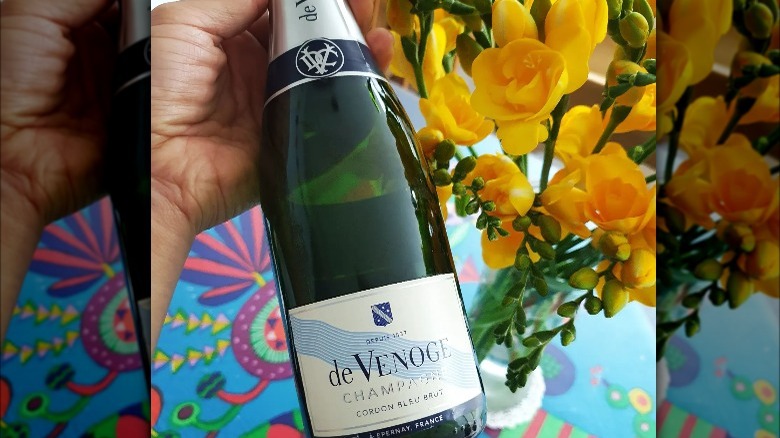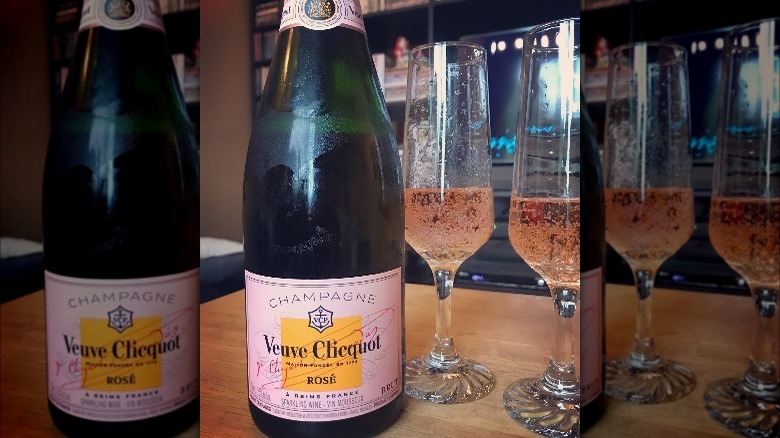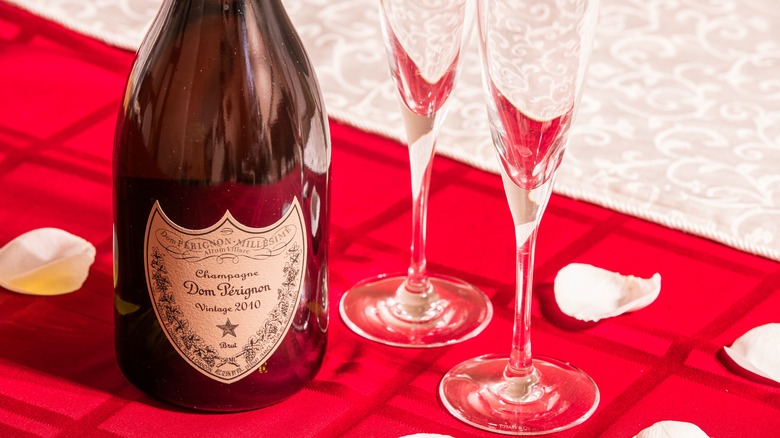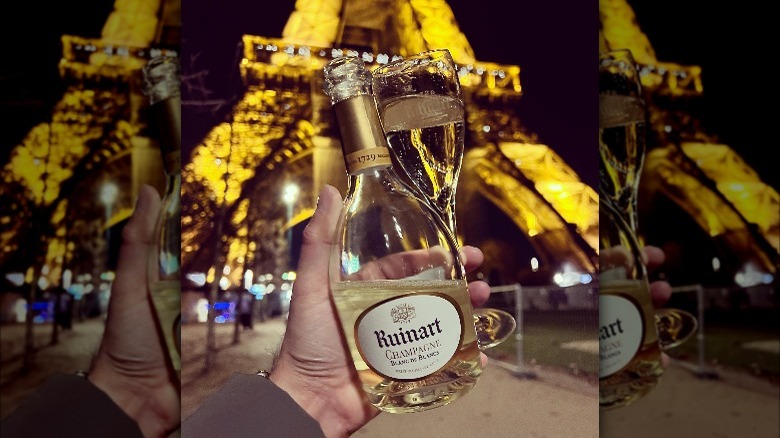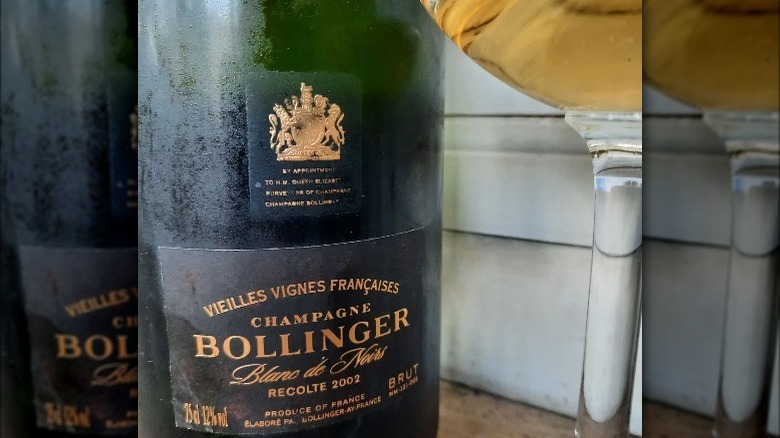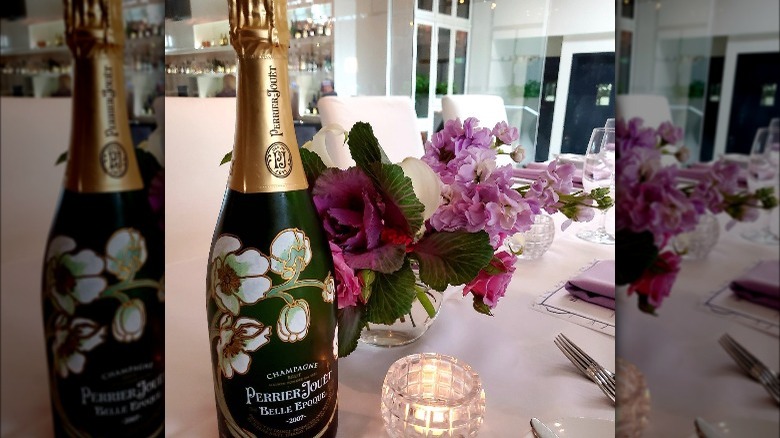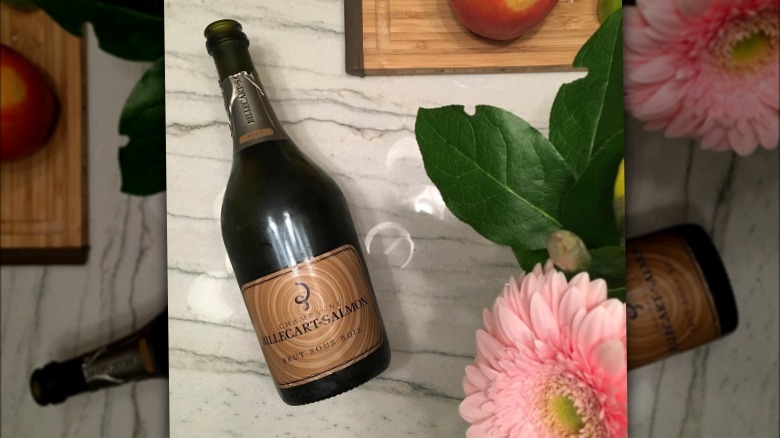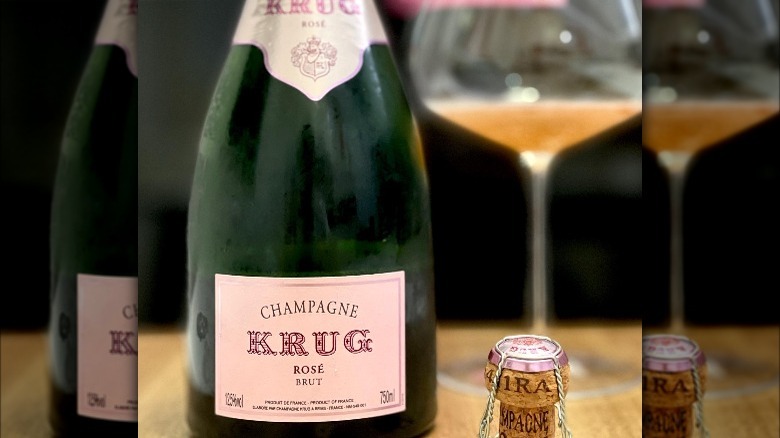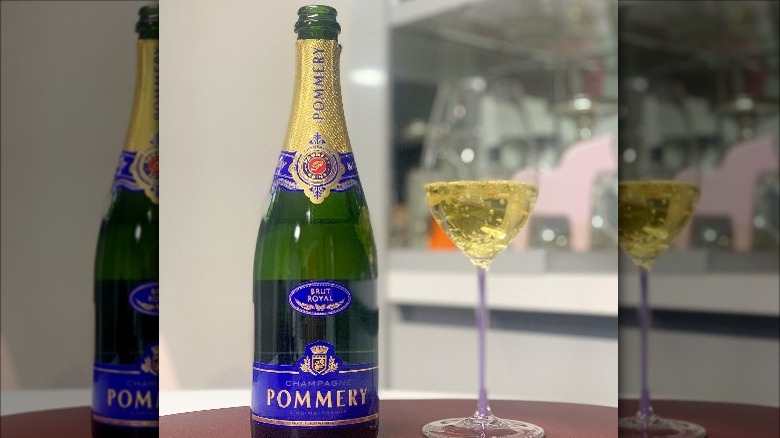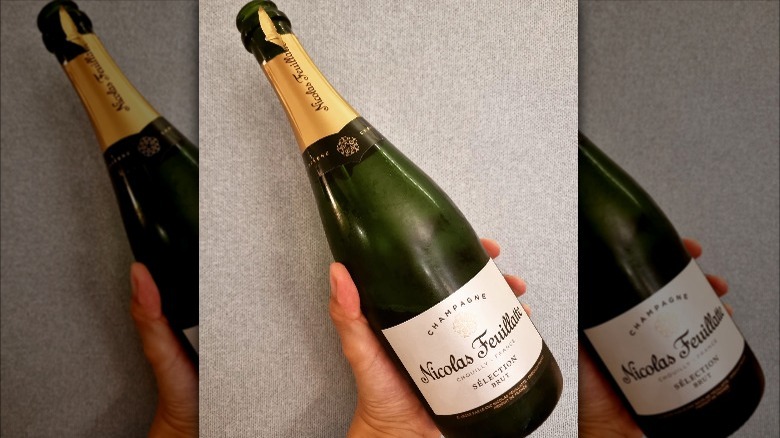The 12 Best Champagnes To Use For Mimosas
Champagne is both delicious and indulgent. The dry and sparkling wine has all but become synonymous with everything luxurious and refined, and ideally, we would all have a little more of it.
According to the World History Encyclopedia, Champagne has a long and fabled tradition dating as far back as the 17th Century. According to legend, the first glass of Champagne was said to be made by the now legendary household name Dom Perignon. Whether or not this is true, Champagne has long been a part of French and international cuisine.
Perhaps as a testament to the true staying power and unexpected versatility of this wine, Champagne has found a home in perhaps a more unexpected place: The brunch table! Mimosas, especially the bottomless kind, have become a welcome addition to America's favorite weekend tradition.
The Washington Post even observed in 2018 that mimosas and brunch go hand-in-hand, though it needn't necessarily be "cheap" Champagne in the mix. It's an easy enough recipe that it doesn't take much know-how to make a truly boozy beauty at any price. There are some varieties of Champagne that will lead to astounding mimosas.
1. Veuve Clicquot Yellow Label Brut Champagne
The Veuve, or widow, Clicquot has done many remarkable things for the Champagne industry, so much so that journalists at Smithsonian Magazine even claim that she invented the modern Champagne game. It's nothing short of amazing, and all brunch-goers truly can raise a glass to her still! Among her best contributions is the iconic Veuve Clicquot Yellow Label Brut Champagne, otherwise referred to as Yellow Label.
The Wine Library describes Yellow Label as being a total knock-out. When popping open a bottle of it, bon vivants can expect the highest quality. The Champagne is made from a mix of Pinot grapes and Chardonnay grapes which creates a truly bright, yet bold, Champagne that combines the best of both worlds. Because Yellow Label is a Brut Champagne, it is exceptionally dry and crisp.
Yellow Label, when combined with orange juice, renders a truly electrifying and striking mimosa. The Champagne's complex fruity and candy notes paradoxically add depth to what would otherwise be a uniformly sickly sweet drink.
All in all, the Yellow Label is one of the best choices on the market, available at what could be considered a midrange price. One bottle of Veuve Clicquot Yellow Label Brut costs around $48 as of December 2022.
2. Canard-Duchêne Brut Champagne
Canard-Duchêne is a somewhat younger Champagne house that was first established in the 19th Century, albeit with love (via Wine.com). The name actually comes from Victor Canard and Léonie Duchêne, a married couple who founded the brand and created its first Champagne.
The Champagne makers' vineyards, based in the small mountainside village of Ludes, have access to unique soil that grows truly exceptional Pinot noir grapes that are intense in flavor and bold in nature (via Canard-Duchêne). The vineyard's site describes said grapes as having exquisite fruity flavors that include cherry, redcurrant, and raspberry, among others. It makes for a truly flavorful glass of Champers!
The Canard-Duchêne Brut Champagne strikes an exemplary mix of bold fruity flavors with a supremely refreshing character. The Champagne's brioche notes are especially worth noting as they add a yeasty element to this particular bottle.
This more grounded bread-like flavor is complimented well by orange or apple juice while adding a depth that one might not usually expect with a run-of-the-mill mimosa. The Canard-Duchêne's Brut is definitely not heavy, so you're sure to leave the brunch table still in high spirits, depending on how many glasses you indulge in!
3. De Venoge Cordon Bleu Brut
De Venoge's "Cordon Bleu" Brut perfectly exemplifies the age-old saying which asserts that fortune favors the bold, and this Champagne certainly is bold! According to Wine Searcher, Pinot noir grapes are responsible for as much as 50% of the Cordon Bleu Brut's composition.
This results in an extremely forward flavor that has bright and fruity notes, which are fortified with a very sturdy structure (via Glass of Bubbly). The other half of the Champagne is made from both Chardonnay and Pinot Meunier grapes, which add a floral crispness and well-roundedness, respectively (via Advanced Mixology).
De Venoge's Cordon Bleu blend reaches the highest and most perfect notes, quite literally! The Champagne has won multiple national and international awards between 2017 and 2021, which has established the Champagne as a cut above the rest.
The International Wine Challenge of 2018 specifically praised the Cordon Bleu for its red fruit and red apple flavors, which will certainly add a crispness to any mimosa. Lobster and crab, among other shellfish, make a wonderful complement to the Cordon Bleu's vibes. A brunch filled with lobsters and mimosas ranks pretty high among life's delights.
4. Veuve Clicquot Rosé
Not everyone can say that they've invented rosé, but the Veuve Clicquot wasn't just anyone (via Veuve Clicquot). The Champagne trailblazer truly forged her own path, and at times, that path was pink, like in 1818, when she brewed up the first batch of Rosé Champagne! To achieve a rosé Champagne, the vignerons need to combine their Champagne blend with just a bit of reserve red wine, which is what gives this wine its distinct color and bold flavor.
Wine.com describes Veuve Clicquot's Champagne Rosé as combing fruit like raspberries, wild strawberries, and blackberries with more bread-like notes like brioche and almonds. This Champagne has a unique unity to it that'll leave you rethinking just what a rosé can be.
One reviewer on Wine.com, James Suckling, notes that the Veuve Clicquot Champagne Rosé leans more towards Pinot noir tendencies, albeit with a notably spicy aroma. The spice notes in this rosé make it suitable for both winter and summer mimosas. This rosé Champagne will add a bit of fruitiness and spice to wherever it lands in whichever season.
5. Dom Perignon
According to Champagne Gallery, it's a romantic myth that Dom Perignon announced that he was "tasting stars" as he first sipped on Champagne. What is true, however, is that the monk was a pioneer that set the course for this luxury wine. Perignon was able to set a clear set of guidelines for Champagne production and develop bottles that stored the bubbly all the better, which no doubt pushed the status of the wine forward and set the level of quality that Champagne is associated with today.
Perignon's contributions were so important that to this day, the name Dom Perignon remains synonymous with the drink itself. Currently, Dom Perignon Brut Champagne is the third most popular wine in France and remains heralded by critics as some of the best Champagne to buy (via Wine Searcher). There's a reason why Perignon has been held in such high regard: It has a refreshing sparkling character that makes good Champagne great.
This drink has wonderful notes of smokiness, saltiness, and citrus. While this Champagne may seem like it is too intense to be paired with OJ, a nice, freshly squeezed orange juice will add a laid-back element to the legendary Champagne. But mimosas needn't only be made solely with orange juice, as grapefruit juice will also make for an amazing partner.
6. Ruinart Blanc de Blancs
The name "blanc de blancs" means white of whites (via Wine Magazine). This somewhat poetic name has roots in the Champagne's ingredients. Unlike other types of Champagne, blanc de blancs specifically and solely use white wine grapes. While this may seem like a minute difference, it makes for a unique style of Champagne. Blanc de blancs Champagnes are extremely refreshing while still being well-balanced.
So, one can expect an extremely crisp mimosa when using blanc de blancs. When making drinks, this genre of Champagne makes for a really flavorful Mimosa that cuts a bit deeper. The Ruinart Blanc de Blancs is a wonderful contender among the various choices and genres of Champagne.
The Champagne has all the refreshing qualities that define blanc de blancs Champagnes. Additional botanical and lemon flavors and a notable smoothness only work to further refine the Champagne. The Ruinart Blanc de Blancs is both light and incredibly rich, and it would make an ideal match for citrus juices, like an especially refreshing lemonade.
7. Bollinger Vieilles Vignes Françaises
Vieilles Vignes translates as "old vines," which means that this particular wine is sourced from older grape plants (via Hancock's). The "old vines" title is usually applied to wines that are cultivated from plants that are at least 30 to 40 years old. There's a reason why "ages like a fine wine" is a saying, as it's pretty widely believed that an older grape vine will produce a better, more refined wine.
Bollinger Vieilles Vignes Françaises is sourced from the vineyard's oldest vines (as per Wine Searcher). This particular Champagne is a Blanc de Noirs, which is the polar opposite of blanc de blancs Champagnes. Blanc de Noirs, or white of blacks, is made exclusively from red wine grapes. This particular Champagne style is extremely rich and structured, and it tends to have heavier fruit aromas.
The Bollinger Vieilles Vignes is a critically acclaimed Champagne, and in 2022, it was the most popular Champagne in the entire region. Due to the wine's age, and Bollinger's general reputation, this particular Champagne has a heftier price tag and sells for an average of around $1,600. For heavier brunches, Vieilles Vignes can be paired nicely with blackberry or cranberry juice.
8. Perrier Jouët Grand Brut
Perrier-Jouët is another Champagne vineyard born out of love. When Pierre-Nicolas Perrier and Rose-Adélaïde Jouët wed, they had the dream of building a house together: A Champagne house, that is (via Perrier-Jouët). To this day, the couple's values of creativity, boldness, and love of all things nature still influence their Champagnes, like with the absolutely royal Grand Brut.
Perrier-Jouët Grand Brut is truly a grand Champagne that Total Wine praises for its honey, mineral, and even slightly sweet citrus notes. It's both a one-of-a-kind and quintessential Champagne that would really shine on the breakfast table. Its especially dry character, due to its Brut genre, makes it particularly refreshing.
Due to the recipe's complex flavors, this specific Grand would pair perfectly with an extremely fresh orange juice. One reviewer on Total Wine notes that Perrier-Jouët's Grand Brut works wonderfully with soft cheeses specifically, so it could certainly be worthwhile to include a charcuterie board with the rest of your brunch's stylings.
9. Billecart-Salmon Brut Sous Bois
Billecart-Salmon Brut Sous Bois is certainly a mouthful of a name, but it's also a wonderful mouthful of Champagne. Billecart is among legendary Champagne houses, and it celebrated its 200th birthday in 2018 (via Champagne Billecart). The Billecart-Salmon Brut Sous Bois certainly belongs among stars.
This Champagne is a cuvée, which means this particular bottle was sourced from the first half of the wine casket (via Wine Academy). Cuvées are supposed to be especially smooth, high-quality wines. Though, as with everything, it does remain a matter of taste.
Billecart-Salmon's Brut Sous Bois is described by the Champagne house as encapsulating all the best aspects of sparkling wine. The Brut Sous Bois is particularly flavorful with notes of brioche, which are heavenly when paired with the Champagne's somewhat buttery elements.
When it comes to mimosas, this would work wonderfully even with an apple cider to make for a warming winter or autumn mimosa. Food-wise, the Champagne house recommends serving poultry and mushroom-based dishes with the Sous Bois.
10. Krug Rosé
There are a few things in life that look incredibly good when looked at through rose-tinted glasses, and the Krug Rosé Champagne is one of those things. Morrel Wine, the house behind the drink, notes that although the rosé is among its younger drinks, it was first made in 1976.
Nonetheless, this rosé is still one that has been made with the utmost attention and care: A vintage Champagne is used as the base ingredient, and red reserve wines are added in to give this rosé its rose. The winemakers assure that the bottles are then aged between 6 and 7 years before ever being sold.
Wine Searcher describes the rosé as extremely sophisticated, with a tenuous yet harmonious balance of competing flavors: Rose hips, pepper, pink grapefruit, mulberries, and even ham can be tasted, if only ever so slightly. It's truly a Champagne with aplomb, and this has only ever been reflected in the numerous accolades and the general popularity that the drink has enjoyed in years prior.
Both meat and fish will do well with this Champagne, and when it comes to mimosas, citrus-based juices will bring out the very best in the cocktail. Grape juice, for example, will bring out the more nuanced elements of this exceptionally special Champagne.
11. Pommery Brut Royal
There's no point in mentioning many fantastic Brut Champagnes without talking about the (alleged) pioneer brew! The Pommery Champagne House is said, at least by those over at VinoVest, to have cultivated the first Brut Champagne near the end of the 19th Century. At the time, Brut Champagne was extremely different from the sweeter Champagnes that were the norm at the time.
Pommery remains experimental to this day, and even 200 years later, its Champagnes can delight just as much as they surprise. The Pommery Royal Brut is a cuvée Champagne that's cultivated from three grape varieties: Pinot noir, Pinot Meunier, and Chardonnay.
It's perhaps because of this that the Champagne hits all the right notes: White fruits with a refreshingly dry citrus finish and an incredibly dry character (via Total Wine). It's a real knock-out that is more affordable than other Champagne options, coming in at $39.99 as of December 2022. This champagne will beautifully complement orange juice or cranberry juice.
12. Nicolas Feuillatte Sélection Brut
The Feuillatte Champagne house was founded after the First World War in 1926 (via Nicolas Feuillatte). It's interesting to note that the Champagne from this particular winemaker was made specifically with an American audience in mind. The company's founder, having long traded in the United States, first made the namesake Nicolas Feuillatte Champagne in the '70s with the hopes of selling it across the Atlantic.
The Nicolas Feuillatte Sélection Brut is, according to reviewers on Wine Searcher, sweeter than the average brut, with slightly fruity notes. It's priced at around $37, and it won international wine competitions consistently between 2012 and 2022.
Its red fruit elements, dry character, and sweetness are a lovely combination that would do well with an orange or lemon juice, perhaps even with a slight bit of sage in the latter. It's exciting to note that the Nicolas Feuillatte is an explicitly kosher Champagne that can accommodate different diets at the brunch table.
